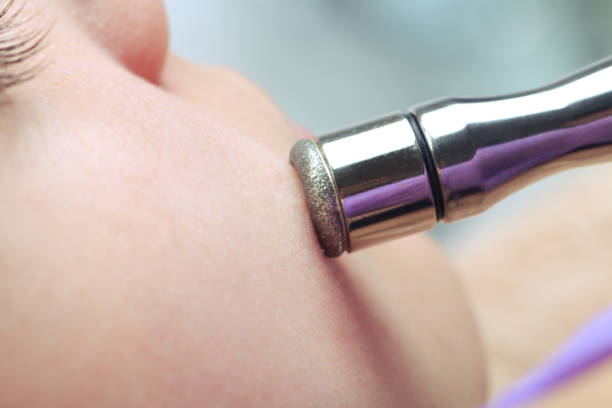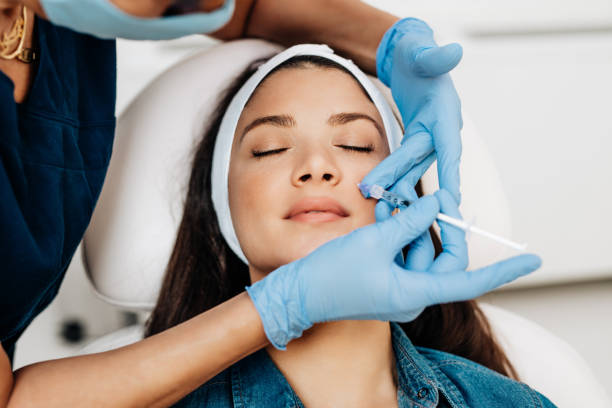
Microdermabrasion is a minimally invasive cosmetic treatment that offers a range of benefits such as revitalizing the skin, reducing signs of aging, and improving skin texture and tone.
If you want to achieve the best results from microdermabrasion, the frequency of getting the treatment is equally important. Ideally, you should get microdermabrasion treatments every four to six weeks to allow your skin enough time to regenerate fully. However, the frequency of the treatments depends on individual skin type and condition, as well as the extent of the skin concerns to be addressed.
It’s crucial to consult with a professional dermatologist or esthetician for advice and determine the appropriate schedule based on your skin health goals. Overdoing the treatments can lead to adverse effects such as skin irritation, inflammation, and sensitivity. So, it’s best to stick to a moderate and consistent schedule.
Improves Skin Texture and Quality
Microdermabrasion is a safe, non-invasive treatment that helps to improve the texture and quality of the skin by using a light vacuum suction to exfoliate the surface of the skin. This treatment can be used to reduce wrinkles, scarring, discoloration, sun damage, and other signs of aging. It can also be used to improve the overall quality and texture of the skin, making it look better, smoother, and more even.
In this article, we will explore how often to get microdermabrasion for optimum skin health.
What Is Microdermabrasion?
Microdermabrasion is a minimally invasive cosmetic procedure that uses a tool to remove dead skin cells and impurities from the surface of your skin. This treatment can improve skin texture, reduce the appearance of fine lines and wrinkles, and boost collagen production.
Benefits of Microdermabrasion:
- Brighter and smoother skin texture
- Reduction of fine lines and wrinkles
- Diminished appearance of scars and age spots
- Increased collagen production for tighter, firmer skin
- Decreased pore size and fewer breakouts
As for how often to get microdermabrasion, it depends on your skin type and the severity of any skin concerns you may have. Those with sensitive skin may only need the treatment once every few months, while those with more significant issues may require more frequent sessions. Consult with a skincare professional to determine the best treatment plan for you.
How Does It Work?
Microdermabrasion is a non-invasive cosmetic procedure that exfoliates the skin’s surface using tiny crystals or a diamond tip. The procedure removes dead skin cells, revealing smoother, brighter, and healthier-looking skin. Microdermabrasion works by using either a spray of crystals or a diamond tip wand to exfoliate the outermost layer of your skin. The procedure is painless and requires no anesthesia. The duration of the treatment and frequency of sessions depend on your skin type and the desired results.
Typically, microdermabrasion sessions take approximately 30-40 minutes and are performed every two to four weeks for optimal results. The frequency of the procedure can vary depending on the individual’s skin type and the severity of skin concerns. As microdermabrasion only removes the outermost layer of the skin, it is safe to undergo it frequently. However, it is recommended to consult with a dermatologist before scheduling your appointments.
What Are The Benefits Of Microdermabrasion For The Skin?
Microdermabrasion is a minimally invasive cosmetic procedure that uses fine crystals or diamond-tipped applicators to exfoliate and remove the top layer of dead skin cells, revealing a smoother, brighter, and more youthful complexion.
Here are some of the benefits of microdermabrasion for the skin:
- It improves skin texture and quality by removing dead skin cells, reducing fine lines, acne scars and blemishes, and increasing collagen production.
- It enhances blood flow and lymphatic drainage, which can improve skin elasticity and firmness.
- It can also help to unclog pores, reduce blackheads and whiteheads, and prevent future breakouts.
However, it is recommended to get microdermabrasion treatments once a month, depending on the skin’s sensitivity, to avoid over-exfoliation and damage. Always consult with an experienced dermatologist or aesthetician to determine how often to get microdermabrasion treatments.
Helps Reduce Fine Lines and Wrinkles
Microdermabrasion is a popular and effective procedure that is becoming increasingly popular for its ability to reduce fine lines and wrinkles. It uses a special device to exfoliate the skin, removing the top layer of dead cells on the skin’s surface. This can help improve your skin’s texture and appearance, making it look younger and healthier.
Let’s look at how often you should get microdermabrasion and the other benefits it can provide.
What Are Fine Lines and Wrinkles?
Fine lines and wrinkles are a natural part of aging where the skin loses elasticity and firmness. Fine lines are shallow, while wrinkles are deeper and more permanent. They mostly occur on the face, neck, and hands, which are frequently exposed to sunlight, pollutants, and other environmental factors. Microdermabrasion is an effective skincare treatment that reduces fine lines and wrinkles by exfoliating the skin and promoting cell regeneration. It involves using a gentle abrasive device to remove the outer layer of dead skin cells, revealing smoother, younger-looking skin underneath.
To achieve optimal results, it’s recommended to get microdermabrasion treatments once every 4 to 6 weeks. However, the frequency may vary based on skin type, health, and other factors. It’s best to consult with a dermatologist or skin care professional to determine the ideal frequency for your skin.

How Does Microdermabrasion Help Reduce Them?
Microdermabrasion is an effective treatment for minimizing the appearance of fine lines and wrinkles on the skin. The process involves using a specialized device to exfoliate the outermost layer of skin, which stimulates collagen production and promotes new cell growth, resulting in smoother, more youthful-looking skin.
Microdermabrasion treatments should be done every 2-4 weeks for optimal results. However, the frequency of treatments may vary depending on individual skin type and concerns. It is recommended to consult with a dermatologist or skin care professional to determine the appropriate treatment plan for your skin.
Pro Tip: Consistent use of sunscreen and hydration can also help maintain the results of microdermabrasion treatments, ensuring long-lasting benefits for your skin.
How Often To Get Microdermabrasion
Microdermabrasion is a non-invasive skin treatment that gently exfoliates the top layer of dead skin cells, revealing smoother, brighter, and more youthful-looking skin. But, how often should you undergo microdermabrasion for optimal results? Generally, it is recommended to undergo microdermabrasion treatments once every two to four weeks. However, the frequency of your treatments will also depend on your skin type, concerns, and goals.
For instance, if you have oily, acne-prone skin, you may benefit from more frequent treatments. On the other hand, if you have dry or sensitive skin, you may need to space out your treatments to avoid irritation and redness. Consult with a licensed skin care professional to determine the best course of treatment and frequency for your unique skin concerns and goals. Pro Tip: Be sure to follow a consistent at-home skincare regimen to maintain your results in between treatments.
Improves Skin Discoloration and Scarring
Microdermabrasion is a non-invasive skin rejuvenation treatment that exfoliates the top layer of the skin to help improve discolorations, age spots, and scarring. This procedure can be beneficial for those seeking skin restoration. But how often should you get microdermabrasion to get the skin you desire? Let’s take a look.
What Is Skin Discoloration?
Skin discoloration refers to the uneven, patchy, or splotchy appearance of the skin, which can occur due to various reasons, including sun damage, hormonal changes, genetics, and skin injuries. Microdermabrasion, a non-invasive cosmetic procedure, has been found to be effective in improving skin discoloration and scarring, among other skincare benefits.
Microdermabrasion, which involves using tiny exfoliating crystals to remove the outer layer of dead skin cells, can be done every 2-4 weeks, depending on your skin’s sensitivity and the severity of the skin problem you’re trying to address. Overdoing it can damage the skin’s protective barrier and worsen skin discoloration. It is best to consult a dermatologist to determine how often you should undergo microdermabrasion, as well as to discuss other suitable treatments and skincare routines that work best for your skin type.
Pro tip: Protect your skin from sun damage by using sunscreen and trying to minimize sun exposure, which can worsen skin discoloration.
What Type Of Scarring Can Microdermabrasion Help With?
Microdermabrasion is a skin rejuvenation treatment that can help reduce the appearance of various types of scarring and skin discoloration.
Here are the types of scarring that microdermabrasion can improve:
- Acne scarring: Microdermabrasion can gently exfoliate and remove the outer layer of dead skin cells, which can help reduce the appearance of acne scars.
- Pigmentation issues: Microdermabrasion can help minimize dark spots, age spots, and sun damage by removing the dead skin cells that contain excess melanin.
- Fine lines and wrinkles: Microdermabrasion can help improve the texture of your skin and stimulate collagen production, which can help reduce the appearance of fine lines and wrinkles.
It is recommended to get microdermabrasion treatments once every 4-6 weeks to see the best results.
How Does Microdermabrasion Improve Skin Discoloration and Scarring?
Microdermabrasion is an effective treatment for improving skin discoloration and scarring. During the treatment, a special device is used to remove the outer layer of dead skin cells from the face and neck areas. This process helps to stimulate the production of new, healthy skin cells, which can lead to a brighter, more even complexion and smoother skin texture. Additionally, microdermabrasion can help to reduce the appearance of scars by increasing blood flow to the affected areas and encouraging the growth of new tissue.
While the benefits of microdermabrasion are clear, it’s important to note that the frequency of treatments required can vary depending on individual needs and skin type. Some individuals may see results after just one session, while others may require several sessions spaced out over several weeks or months to achieve optimal results. A skincare professional can provide personalized guidance on how often to get microdermabrasion based on your specific goals and skin concerns.
Safe and Painless
Microdermabrasion is a modern skin rejuvenation treatment that is safe, painless, and perfect for nearly anyone. It is considered a non-invasive procedure, meaning it doesn’t require incisions like some other procedures do. It is also a low-risk procedure that doesn’t require the use of any chemicals or drugs, making it a great choice for those who are wary of major operations or invasive treatments.
What Are the Side Effects of Microdermabrasion?
Microdermabrasion is a safe and painless cosmetic procedure that helps rejuvenate the skin and improve its texture. However, it may cause some side effects depending on a person’s skin type and history of skin sensitivity. Some of the side effects of microdermabrasion include redness, tenderness, and slight swelling. These are usually temporary and can be managed with cold compresses or over-the-counter creams.
People with sensitive skin or those with existing skin conditions like rosacea or eczema may experience more severe side effects like itching, rash, or even scarring. It is best to consult a dermatologist before undergoing microdermabrasion if you have any of these issues.
Microdermabrasion is a gentler exfoliation technique than other procedures, but it is still important not to overdo it. Experts recommend getting microdermabrasion done every 4-6 weeks to allow the skin to heal between treatments. Pro tip: Always do a patch test before getting a full treatment to test for skin sensitivity.
How Does It Compare to Other Skin Treatments?
Microdermabrasion is an effective skin treatment that provides benefits such as smooth, youthful, and glowing skin without any pain and risk. Compared to other skin treatments, microdermabrasion is safer as it is non-invasive and does not use chemicals, needles or anesthesia. It is also a gentler method and doesn’t cause any side effects.
On the other hand, chemical peels and laser treatments are harsher and can cause redness, irritation, and scarring. They should be performed by a trained professional and can have long recovery times. In contrast, microdermabrasion is a simple procedure that can be performed at home or at the dermatologist office. It is recommended to get microdermabrasion every 4-6 weeks to maintain the smoothness and radiance of the skin.

How Often Should You Get Microdermabrasion For Best Results?
Microdermabrasion is a safe and painless cosmetic procedure in which dead skin cells are exfoliated to give you fresh-looking, glowing skin. The frequency of microdermabrasion treatments is dependent on the type of skin you have. If you have oily skin, you can get microdermabrasion treatments every 2-3 weeks to keep your skin hydrated and minimize the appearance of acne scars and wrinkles.
If your skin is sensitive or dry, it’s recommended to opt for a treatment every 4-8 weeks to avoid potential damage to your skin’s natural barrier. Keep in mind that overdoing microdermabrasion treatments can strip away essential oils and lead to skin irritation and redness. Always consult a licensed esthetician to determine the best frequency of treatments that’s right for your skin type.
Cost-Effective and Convenient
Microdermabrasion is a cost-effective and convenient treatment for the skin. It is considered one of the most popular non-invasive cosmetic procedures for skin rejuvenation. Not only does microdermabrasion provide a wide range of skin benefits, but it also requires little to no downtime. In this article, we will discuss the cost-effectiveness and convenience of microdermabrasion and how often it should be done.
How Much Does Microdermabrasion Cost?
Microdermabrasion is a popular cosmetic treatment that uses exfoliation to improve the appearance of the skin’s texture, tone, and clarity. The cost of microdermabrasion varies widely depending on several factors including location, the experience of the technician, and the number of sessions required to achieve your desired results. On average, a single session of microdermabrasion can cost anywhere between $75 to $200, with most people requiring between 5-12 sessions for optimal results. However, some places offer package deals that can significantly reduce the overall cost.
Microdermabrasion is a cost-effective and convenient way to improve the appearance of the skin without any downtime. It’s suitable for all skin types and can help reduce the appearance of fine lines, wrinkles, and age spots. While it’s recommended to get microdermabrasion treatments every 4-6 weeks, the frequency of sessions depends on your skin type, skin condition, and the results you want to achieve.
How Long Does a Typical Microdermabrasion Treatment Take?
A typical microdermabrasion treatment takes approximately 30 to 60 minutes to perform, depending on the area being treated and the extent of the skin issues being addressed. Microdermabrasion is a cost-effective and convenient skincare treatment that offers a range of benefits, including improving skin texture and appearance, reducing fine lines and wrinkles, minimizing hyperpigmentation, and treating acne and acne scars.
The frequency at which you should get microdermabrasion depends on various factors, such as your skin type, the severity of skin issues, and the results you’re seeking. The general rule of thumb is to get microdermabrasion once a month for optimal results. However, some people may require more or less frequent treatments.
Pro tip: Talk to a skincare expert to determine the most suitable frequency of microdermabrasion treatments for your skin type and needs.
How Often Should You Get Microdermabrasion for Best Results?
Microdermabrasion is a non-invasive skin resurfacing treatment that can improve the appearance of uneven skin tone, texture, and fine lines. To achieve the best results, how often to get microdermabrasion plays a crucial role. The frequency of microdermabrasion treatments depends on several factors, including skin type, the severity of skin concerns, and personal preference. In general, most people benefit from a series of 4-6 treatments spaced 2-4 weeks apart for optimal results.
If you have more severe skin concerns such as acne or hyperpigmentation, you may need more frequent treatments initially, followed by maintenance treatments every 4-6 weeks. However, if you are using microdermabrasion for routine maintenance or prevention of early signs of aging, a treatment every 6-8 weeks may suffice. Ultimately, it’s essential to speak with a licensed esthetician or dermatologist to determine the ideal frequency of microdermabrasion treatments based on your skin’s unique needs and concerns.
Pro Tip: Be sure to follow post-treatment care instructions, including avoiding sun exposure, moisturizing, and wearing sunscreen, to maximize the benefits of your treatment.










